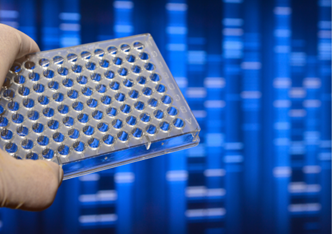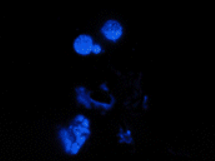Forensic Research
Genetic testing is used for personal identification in medicolegal investigation, and extraction and purification of DNA from body fluids (blood, saliva, etc.) or hair of human bodies are needed as a pretreatment step. Fujifilm Wako offers a line-up of DNA extraction and purification reagents that can be used for body fluids and hair.
For example, although detection of bloodstains is an important task in forensic science, sometimes it is difficult to distinguish bloodstains from other stains. The luminol reaction, leucomalachite green reaction, and the like are used in a preliminary test to determine whether a stain is a bloodstain. We also provides a set for the luminol reaction and a set of reagents for the leucomalachite green reaction, both of which require little effort for reagent preparation. In addition, the presence of prostate-derived acid phosphatase proves the presence of semen. Fujifilm Wako provides SM reagents , which can detect the presence of acid phosphatase.
More Information
What is Forensic Research?
Forensic research (Forensic science) is defined as a field of medical science with the intended purpose as to contribute to the protection of fundamental human rights and the maintenance of social safety and welfare by making scientific and fair medical decisions concerning legal affairs and matters that require medical advice for clarification1).
As for judicial affairs, examinations and appraisals are performed from a medical perspective and materials necessary for investigations and judgments are provided. Specifically, examinations such as personal identification of living people, parentage identification, and wound identification; autopsy and dissection for identifying the cause of death; and examination of traces such as bloodstains, semen, hair, and fingerprints left on objects or at crime scenes. As for public administration affairs, autopsies of unidentified dead bodies and personal identification of missing people are performed. As for legislative affairs, forensic research is involved in the establishment and amendment of laws from a medical perspective.
Tests in Forensic Research
A variety of tests are used in forensic research. Some representative tests are as follows:
DNA testing

Personal identification and parentage identification are performed based on DNA sequence information. Various samples are used, including hair, saliva, blood, bone, and teeth, and it is necessary to select DNA extraction and purification reagents suitable for the sample. After DNA extraction and purification, specific DNA regions are amplified by PCR, and the amplified DNA fragments are analyzed by electrophoresis or a sequencer. The DNA regions selected to be analyzed are those with sequence variations among individuals, that is, diversity. The following polymorphic regions are mainly used:2)
(1) VNTR (Variable Number of Tandem Repeat)
VNTR is a region in which a short sequence unit of ten to several tens of bases is repeated, and the number of the repeats varies among individuals. It is considered that there are several thousands of VNTRs in the nuclear DNA.
(2) STR (Short Tandem Repeat)
STR is a region in which a sequence unit of 2-5 bases, which is shorter than for a VNTR, is repeated, and the number of these repeats varies among individuals, similar to VNTRs. It also known as microsatellite. As the length of DNA to be amplified is shorter than that of VNTRs, amplification is comparatively easy. In addition, an STR can be applied to samples for which the DNA is deteriorated. Therefore, STRs have been predominantly used in DNA testing.
(3) SNP (Single Nucleotide Polymorphism)
SNPs, in which a base is replaced by another base, are used for personal identification similar to VNTRs and STRs. Although the ability to identify individuals is not as high as that with VNTRs or STRs, this limitation can be addressed by simultaneous analysis of multiple SNPs.
(4) Mitochondrial DNA Polymorphism
Mitochondria are the site of energy production in cells and are inherited from the mother. Analysis of mitochondrial DNA polymorphisms (mainly SNPs) enables personal identification.
Bloodstain Testing

Bloodstains are important for estimating the circumstances of a crime or accident and identifying people who were involved in it. A biochemical test called preliminary bloodstain test is performed first to find out whether a sample is a bloodstain or not. A reagent such as luminol or leucomalachite green is used in the preliminary bloodstain test. When the sample is considered highly likely to be blood in the preliminary bloodstain test, a human/animal blood discrimination test or bloodstain test is performed.
Luminol reacts with hydrogen peroxide in alkaline aqueous solution by catalytic action of a substance with peroxidase-like activity (hemoglobin, etc.) and emits pale light, which enables detection of the presence of blood. Although it has excellent sensitivity and can be applied to invisible stains, it has a disadvantage of low specificity, because it also reacts with peroxidases other than blood. As for leucomalachite green, colorless leucomalachite green is oxidized by a redox reaction catalyzed by heme in blood to be blue-green malachite green, which enables detection of blood. Although it is less sensitive than luminol, its advantage is high specificity.
Semen Testing

Semen is important evidence for sexual crimes and the like. Whether adhered substance is semen or not is determined based on appearance, microscopic examination, serology, and biochemical test results.
Biochemical tests used for semen testing include the detection of prostate-derived acid phosphatase, which exists abundantly in human semen. The SM reagents used in this procedure turn bright purple in the presence of acid phosphatase.
References
- Japanese Society of Legal Medicine: http://www.jslm.jp/about/definition.html (May 3rd, 2021) (Japanese)
- Nagai, A.: Medical Imaging and Information Sciences, 28(3), 66(2021).
Roles of Examinations in Legal Medicine - From the Basics of DNA Typing to Postmortem Imaging - (Japanese)
For research use or further manufacturing use only. Not for use in diagnostic procedures.
Product content may differ from the actual image due to minor specification changes etc.
If the revision of product standards and packaging standards has been made, there is a case where the actual product specifications and images are different.



